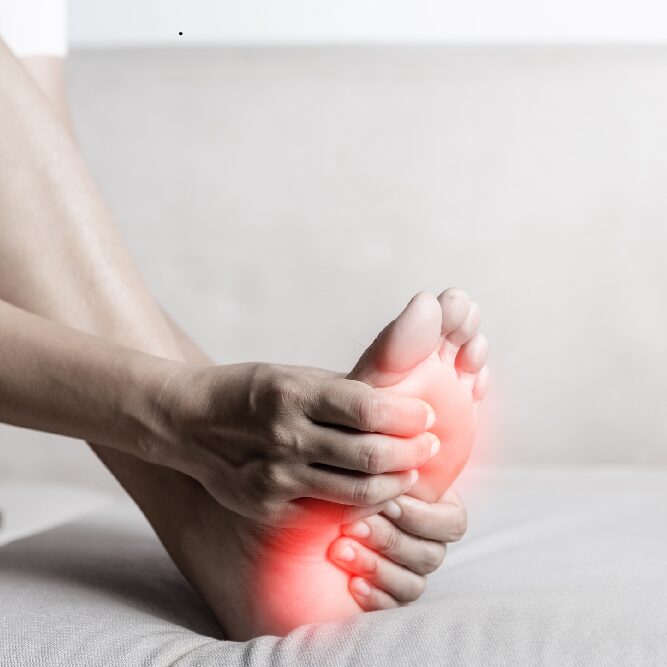Plantar fasciitis is a common foot condition that causes pain and inflammation in the plantar fascia, a thick band of tissue that runs along the bottom of the foot, connecting the heel to the toes. It often develops due to overuse, poor footwear, tight calf muscles, or improper foot mechanics. The pain is typically worse in the morning or after long periods of rest.
The good news? With the right combination of mobility, strength, and mindful movement, Pilates can be an effective way to ease symptoms, improve foot function, and support overall lower-body alignment.
Why Does Plantar Fasciitis Develop?
Plantar fasciitis often appears suddenly, but it typically results from a combination of strain, biomechanics issues, and external factors.
1️⃣ Sudden Increase in Activity
• Rapidly increasing walking, running, or standing time
• Switching to a new workout routine with more weight-bearing or high-impact exercises
• Starting a new job that requires prolonged standing
2️⃣ Footwear Issues
• Wearing unsupportive shoes (thin soles, lack of arch support)
• Sudden switch to flat shoes or barefoot walking
• High heels reducing foot flexibility and leading to strain when transitioning to flats
3️⃣ Tight or Weak Muscles
• Tight calf muscles or Achilles tendons pulling on the plantar fascia
• Weak foot or ankle muscles causing instability
• Reduced flexibility in the arches of the foot
4️⃣ Weight & Impact-Related Factors
• Sudden weight gain (pregnancy, lifestyle changes, etc.)
• Excessive jumping or running on hard surfaces
• High-impact sports without proper recovery
5️⃣ Biomechanics & Posture Issues
• Flat feet or high arches causing foot misalignment
• Over pronation (rolling the foot inward) when walking
• Weak glutes and hips affecting foot mechanics
How Long Does Plantar Fasciitis Last?
The duration varies depending on severity, treatment, and lifestyle adjustments:
📌 Mild Cases: Can improve within a few weeks to 3 months with proper care
📌 Chronic Cases: May persist for 6–12 months or longer if left untreated
Early intervention, including mobility exercises and supportive footwear, can significantly reduce recovery time.
Pilates for Plantar Fasciitis: Best Exercises & Modifications
Pilates offers a low-impact approach to strengthening and stabilising the foot while promoting overall alignment. When practiced mindfully, it can help alleviate pain and prevent further strain.
✅ Focus on Mobility, Strength, and Stretching
1️⃣ Foot & Ankle Mobility
✔ Foot Circles (seated or standing) – Improves range of motion
✔ Toe Scrunches/Towel Grabs – Strengthens foot muscles
✔ Rolling a Ball Under the Foot – Releases tension and increases circulation
2️⃣ Calf & Achilles Stretches
✔ Modified Downward Dog – Gently stretches the plantar fascia and calves
✔ Seated or Standing Calf Stretch – Can be done against a wall or using a resistance band
✔ Heel Drops on a Step – Lengthens the Achilles tendon and plantar fascia
3️⃣ Strengthening the Lower Leg & Foot
✔ Toe Taps (seated or standing) – Engages foot and arch muscles
✔ Single-Leg Balance Work – Enhances foot and ankle stability
✔ Resistance Band Foot Flexion & Extension – Strengthens foot and ankle mobility
4️⃣ Gentle Core & Hip Strengthening
✔ Glute Bridges – Strengthens the glutes to support foot alignment
✔ Clamshells & Side-Lying Leg Lifts – Promotes hip stability, reducing strain on the feet
Exercises & Movements to Avoid
While Pilates can be beneficial, some movements may aggravate plantar fasciitis by placing excessive strain on the foot.
🚫 Jumping or Plyometric Movements – Adds excessive stress to the plantar fascia
🚫 Full Plank & Toe-Dominant Movements – Opt for forearm planks or knee-supported variations
🚫 Standing Work Without Proper Support – Modify balance exercises if pain is present
🚫 Excessive Dorsiflexion (Toe Stretching) Too Soon – Overstretching can worsen symptoms
Additional Tips for Managing Plantar Fasciitis in exercise
💡 Modify Standing Work – Use a soft surface or towel for cushioning during prolonged standing exercises
💡 Wear Supportive Footwear – If barefoot practice increases discomfort, consider grip socks or arch-support insoles
💡 Use Props for Support – Blocks, small balls, or foam rollers can assist in certain movements
💡 Gradual Progression – Avoid aggressive stretching or prolonged weight-bearing exercises too soon
Final Thoughts
Plantar fasciitis can be frustrating, but the right movement strategies can make a significant difference. Pilates offers a controlled, low-impact way to strengthen, stretch, and stabilise the foot, reducing pain and improving overall function. By incorporating mobility exercises, strengthening the lower body, and modifying certain movements, Pilates can help support long-term foot health and comfort.
Would you like to explore a personalised Pilates routine for foot health? Let’s start the conversation!

